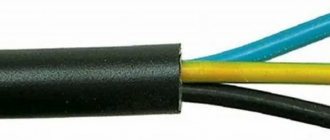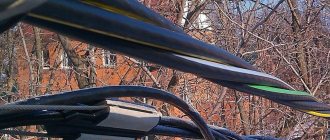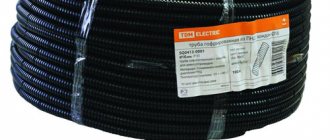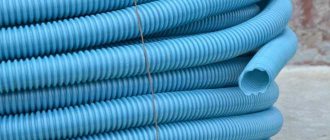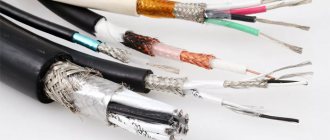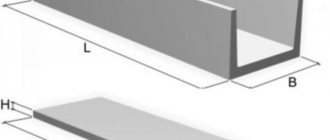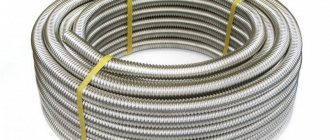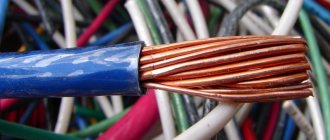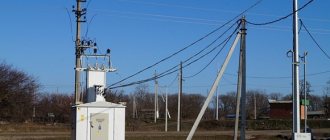There are many ways to protect electrical wiring from external influences. The cable is covered with a durable sheath, walled up in the wall, and hidden behind a suspended ceiling. Finally, they are placed in special plastic boxes. All these methods really increase the survivability of the wiring, but do not protect it from mechanical stress. For example, drilling a wall, hitting with a chisel or an ax, displacing load-bearing structures, passing vehicles. The only way to make the power wiring installation self-protective is to use steel wiring pipe.
Not to be confused with steel corrugation. This method of protection is also not bad, but thin-walled corrugation is not so strong.
Installing electrical wiring in pipes really solves many problems, but the cost of organizing energy supply increases significantly. The electrical installation rules (PUE) do not provide for the conditions under which laying a cable in a metal pipe becomes mandatory. However, in practice there are situations when the safety requirements of the PUE can only be implemented by organizing cable wiring in metal pipes.
Why are wires laid in pipes?
According to PUE 2.2.20 (Rules for the construction of electrical installations), conductors subject to mechanical stress must be additionally protected. In addition, the gasket in the pipe provides the following protection:
- from stretching, squeezing, breaking, puncture;
- protects a flammable base or a fire-hazardous room from fire during a short circuit (short circuit);
- prevents sunlight and precipitation from destroying the insulation.
This method is used mainly in industrial premises and when laying in soil.
Using the probe
Depending on the design, HDPE pipes are produced with or without a probe (broach).
A broach is a thin cable or wire that is used to pull the cable into the pipe. To make work easier, it is better to use double corrugation, the inner wall of which is smooth and made of LDPE, which facilitates the passage of wiring.
- Start by measuring the desired length. The excess pipe is cut off with a knife or a special pipe cutter, and the probe is cut with side cutters.
How to stretch a cable using various devices?
In the absence of a probe, cable pulling is possible using various devices. The complexity of the process increases slightly, but the required result is achieved in one of the following ways.
READ ALSO: How to Make a Blowgun From PVC Pipes
The advantage of this option
Given that there are different installation methods, what are the advantages of this method? Since the pipe is round in shape, it is ideal for laying wire or cable in it. As the conductor is pushed through, it bends less frequently, requiring less effort. Such structures have a smooth turn, unlike the box, which also facilitates installation and protects the wire from breaking.
The round section can withstand more load than any other. Cables laid underground in this way will be more protected from compressive loads and surface deformation, for example, during building subsidence.
Using the probe
Depending on the design, HDPE pipes are produced with or without a probe (broach).
A broach is a thin cable or wire that is used to pull the cable into the pipe. To make work easier, it is better to use double corrugation, the inner wall of which is smooth and made of LDPE, which facilitates the passage of wiring.
- Start by measuring the desired length. The excess pipe is cut off with a knife or a special pipe cutter, and the probe is cut with side cutters.
How to stretch a cable using various devices?
In the absence of a probe, cable pulling is possible using various devices. The complexity of the process increases slightly, but the required result is achieved in one of the following ways.
READ ALSO: What is Sdr 21 PVC Pipes
What cables are allowed to be used?
There are no special requirements for wires and cables. According to 2.3.42. PUE, it is permissible to lay cable lines in rubber and plastic insulation without additional protection, since pipes perform this function. The number of shells is also not regulated. The conductors can be copper or aluminum. Each conductor may consist of one or more cores.
When servicing a four-wire network, the cable to be laid must be four-wire (clause 2. 3. 52). This applies to HDPE (low-density polyethylene) pipes; if steel is used and the voltage is up to 1 kV, then according to 1.7.121. the pipe can play the role of a neutral conductor. This is provided that there is no electrical break along the entire route.
It is prohibited to place next to (clause 2. 1. 16.):
- working and backup network;
- working and emergency line;
- circuits up to and above 42 V.
Features of electrical wiring installation
We will consider the technology of installing electrical wiring in pipes using the example of products of various types, differing in their material. Its general order can be represented as the following sequence of actions:
- Marking the planned route for laying on the floor or ceiling of the house.
- Preparation and installation of the selected type of pipeline.
- Pull the electrical cable into it.
The technologies for laying cable lines in pipes of various classes are very similar and differ only in some details (the method of connecting individual spans of pipe routes, in particular).
Steel pipes
To lay metal-based pipe blanks along the walls of a wooden house, for example, you will need to prepare strong steel fasteners that securely hold them at the fixing points.
Couplings, tees and boxes for pipe distribution
The peculiarity of this type of wiring is the inadmissibility of the presence of burrs and sharp edges on the pipe sections, which can damage cable products, as well as the use of special couplings.
Installation of electrical wiring in pipes is shown in the video below.
Another important detail of using iron pipelines (and their disadvantage at the same time) is the electrical conductivity of the walls. In this case, a breakdown of the cable cores into the metal is possible and creates a threat to the residents of a private house. For this reason, today an increasing number of users are choosing plastic or corrugated (non-conductive) pipes for electrical wiring.
Corrugation
This type of pipe blanks for laying electrical wiring is attractive not only for its electrical safety. Due to the flexibility of the corrugation, it is much more convenient to pull installed cables and wire harnesses through it. The same should be said about dismantling in the case of major repairs of premises and replacement of electrical wiring.
Installation of electrical wiring in a corrugated
You can attach flexible hoses in any convenient place, and in this case there is no need for connections at all (usually a piece of the required length is immediately taken).
Electrical wiring in PVC corrugation
The only drawback of these mounting products is their low resistance to mechanical (compressive) loads. For this reason, routes from such pipes are laid along building elements whose likelihood of deformation is minimal.
Plastic
This type of pipeline is something between the two options considered. The plastic is strong enough to reliably “hold” mechanical loads and is moderately flexible so that it is convenient to lay wire harnesses in it.
Electrical wiring in PVC pipes
When choosing an installation location, we proceed from the above considerations and the admissibility of unhindered fastening of the workpieces to the building elements. The service life of these products significantly exceeds that of metal pipes.
Please click one of the buttons below to find out if the article helped or not.
Characteristics of pipes for laying cables in soil
To create cable blocks (2. 3. 102.), it is allowed to use pipes:
- metal (cast iron, steel);
- asbestos-cement;
- concrete;
- ceramic;
- others.
Others also include plastic ones. The choice of material depends on the groundwater level, the presence of an aggressive environment and stray currents. When laying oil-filled single-phase cables, the pipes must be made of non-magnetic material, and one cable must be laid in each of them.
The pipes themselves can be either rigid or flexible. Corrugated polyethylene or metal hoses are used as flexible ones. The DCS (dielectric cable system) catalog provides a large selection of products.
Corrugated pipes
Due to their lightness and flexibility, these types are widely used for laying in the ground. Available in two versions:
- reinforced;
- unreinforced.
The first types are more durable thanks to the steel wire installed during manufacture. A double-wall pipe is especially convenient for installation. The outer layer is made in the form of corrugated HDPE, which has high strength. Internal - made of LDPE (high-density polyethylene) and forms a smooth surface, this makes pulling the cable more convenient.
HDPE easily tolerates ultraviolet radiation and does not corrode, all this makes them suitable for laying external (street) wiring. Some types are equipped with a probe - a cord stretched across the entire length of the pipe. This significantly speeds up the installation process.
Metal pipes
Metal is much stronger than plastic, so such pipes are laid where mechanical strength is especially important. Steel pipes are laid at the intersection:
- tram and railway lines;
- highways;
- entrances to a garage or fence;
- gas and oil pipelines;
- heating mains.
Metal is also used if the route runs along railway or tram tracks, as well as indoors, including in wooden houses. Metal pipes are used for open and hidden installations. In electrical rooms, instead of pipes, it is permissible to use an angle and a channel. They are also widely used for outdoor installation (open, hidden, under a canopy).
Plastic pipes
This type is increasingly used when laying cables or wires. This is due to the characteristics:
- unlike metal pipes, plastic pipes are not subject to corrosion, due to which the service life increases to 50 years;
- being a dielectric, it additionally protects the cable;
- do not require grounding;
- resistant to chemicals and solvents;
- HDPE can be operated at temperatures down to -45 degrees.
Particular attention should be paid to the relatively new material made of cross-linked polyethylene foam (polyethylene). Unlike polyethylene, cross-linked polymer has a number of advantages:
- softening of the material occurs at a temperature of +150 degrees, and melts at +200 degrees;
- has greater rigidity and tensile strength;
- has a high vapor barrier;
- capable of restoring its shape during short-term deformation.
Cross-linked polyethylene is used to insulate high-voltage cables and pipes, and the presence of fittings allows you to lay routes of any configuration.
Wiring under the floor
Installing electrical wiring under the floor is an ideal way to create hidden cabling without resorting to horizontal grooves in the walls. In this case, the cable (main wire) is supplied directly to the locations of sockets, switches and distribution boxes.
The method of creating floor wiring directly depends on what material the floors are planned to be made from. In general, it is necessary to focus on the rules of the PUE that are already known to us.
sergey_savFORUMHOUSE Member
In the voids of building structures - read SP31-110-2003 clause 14.15 or similar - PUE 7 clause 7.1.38. That is, if something in the structure turns out to be flammable (joists, for example), then the direct path is to metal blind boxes and pipes.
If the wiring is installed in the lower layers of the cement floor, then a simple protective corrugation is sufficient for its installation. Of course, it is possible to lay a cable inside the screed without any corrugation at all, but in this case it will not be possible to replace the wiring without resorting to destroying the floor covering. By the way, the difficulty of repairing and replacing cables (wires) is the only significant drawback of floor wiring, and it should definitely be taken into account when deciding on the type of electrical wiring.
So, we have introduced you to the main methods of installing internal electrical wiring, which depend on the characteristics of the building materials in the room. You can read in more detail about the experience of laying cables on various building structures in the corresponding section of our portal. You can learn about additional features of installing wiring on walls, floors and ceilings from the corresponding video. And the article about protecting consumer electronics from sudden voltage surges will be of interest to anyone who does not want to one day face the unpleasant consequences of such a problem.
Technology of laying cables in metal pipes: installation process
Installing cables in pipes is quite labor-intensive and expensive, so it is used when it is necessary to guarantee the cable protection from mechanical stress. Bookmarking is carried out in several stages:
- marking the upcoming route;
- preparation and installation of pipes;
- cabling.
To complete the first point, the installation location is determined and preparatory work is carried out. When installing on the walls of buildings, foundations, partitions, grooves, holes for electrical appliances, transitions, etc. are made. Lengths and bends are measured, the necessary documentation is drawn up and sent to the electrical installation workshop. There the pipes are cleaned, painted, and cut to size. The joints must be processed so that there are no burrs. If necessary, make bends. Finished products are labeled, packaged and sent to the customer.
The installation is carried out in such a way as to prevent the ingress of dust, oil and other substances. To prevent water from accumulating, the laying is made at an angle of at least 2 degrees towards the boxes. Fastening by welding is prohibited; for this you need to use staples, clamps, pads, and clamps. The distance between the fasteners should not be greater than that indicated in the table.
| Outer diameter of pipes, mm | Distance between fastenings, m |
| 18-26 | 2,5 |
| 30-42 | 3,0 |
| 45-90 | 4,0 |
All connections and inputs must be sealed. Then the electrical equipment is installed.
At the final stage, tightening is performed. Check the cleanliness of the pipes, if necessary, they are blown with compressed air, and plastic bushings are put on the ends. Wires and cables are assembled in groups, the cores are tied to steel wire with a diameter of 2-5 mm and pulled through.
Construction of the trench
First, the terrain is marked; the future route must be removed from the foundation, gas pipeline, etc. at the distance specified in the PUE. Then the ground is cleared of plants and debris. Earth-moving equipment is used to dig trenches; where this is not possible, they are dug by hand. The depth is determined by the operating voltage. The bottom is cleaned of debris if necessary, leveled and lined with a sand cushion. Signal tape must be laid on top of the route.
Trenchless method of laying cables in the ground
This is a complex and expensive method, carried out with specialized equipment. It is produced in places where it is impossible to dig a trench due to any circumstances, for example, laying under a reservoir. The bottom line is that horizontal drilling is carried out using an adjustable drill head. Then the channel expands, a HDPE pipe is pulled in which there is a steel cable, and a cable is laid through it using a cable.
Laying cables under the road
In the case where the route must pass through an asphalt road, in order not to disturb its surface, another method of passage is used - a puncture. The rod with the tip is pushed through the soil under the road using machinery. The tip, passing through the thickness, compacts the earth around itself, preventing it from crumbling. This passage is called the starting passage. After the rod has reached the surface, an expander is attached to it and pulled in the opposite direction. The passage widens, and the earth around is compacted even more. A cable line is pulled through it.
Safety requirements
By laying the cable in a metal pipe, it is possible to ensure fire safety and protect the cable itself. But one more problem remains - electrical safety. The metal conducts current; when a bare wire comes into contact with the pipe wall, there is a danger of a person receiving an electric shock, heating up the protective casing, and igniting nearby objects.
It is not enough to simply hide the electrical cable - so that the electrical network does not cause a tragedy, certain requirements must be observed:
- Cables with a triple braid are laid in a metal pipe - even if one layer of braid is damaged during pulling, there will be no contact between the wire and the metal.
- If the voltage in the cable is above 42 V, the casing must be grounded. This will protect against electric shock when touching a pipe that has come into contact with an electrical wire.
- Moisture must not get inside the pipe, as this will lead to corrosion of the casing and destruction of the wire braid. Therefore, the pipe system must be sealed and connections must be reliable.
- If the casing material is susceptible to corrosion, it should be coated with metal paint - this will extend the service life and prevent depressurization of the system.
- The distance from the pipe with the cable to the heating pipe must be at least 20 cm. Near sources of high temperature or open fire, the casing of the electrical cable must be covered with a heat shield - a curved steel plate that will reflect part of the heat.
What you need to know about sizes: diameters, inches and millimeters
First and foremost: the diameter is selected based on the type of cable to be laid. The most popular sizes in household electrical installations are from 16-20 mm to 50 mm. People who are inexperienced in electrical installations often get confused: what are the dimensions, in millimeters or inches?
It's actually simple. Electrical pipes are not measured in inches, but exclusively in millimeters. Inches are from the area of measuring water pipes and mounting elements for them. And we have already talked about the inappropriateness of their use for electrical installations. And now a few words about the diameter. It is logical that each pipe has walls of a certain thickness and, accordingly, two diameters, internal and external. Which one to take into account?
Perhaps a surprising answer: neither the first nor the second. As my interlocutor explained, you will have to focus on the nominal diameter. This means that the specified size satisfies the requirements of GOST, is suitable for laying the appropriate cable and can be easily combined with fasteners of the same conventional size. That is, the conventional 16 mm in fact may be 15.8 mm, but this diameter will work just as well.
In fact, it is not necessary to know exactly the internal and external diameters; use the conditional one as a guide. Dimensions up to a tenth of a millimeter will be needed in isolated cases - for example, the exact outer diameter, when you need to drill a hole with absolutely no gap. In the vast majority of cases, this information is not necessary.
cable in pipes manufactured by DKC
Actually, what is the feasibility?
And look for expediency in the “bible” of electrical installation - a regulatory document called “Rules for the construction of electrical installations.” But we promised to explain the basic principles simply and clearly, so we deliver.
Even when there is no direct need regulated by the PUE, installation in protective pipes is justified in many situations. First of all, where it is necessary to create a physical barrier and distance the cable from the surface to the distance specified by the standards. Plus, this reduces the amount of oxygen available to the cable in the event of a fire.
Walls made of plastic or metal (correctly selected for specific operating conditions) can withstand external pressure and are resistant to aggressive substances such as acids and solvents.
It would be a good idea to provide protection for the cable from damage by rodents.
Additionally, the cable in the pipes is protected from possible exposure to moisture. You can’t do without a special reinforced corrugation (I’ll specify which one later) when making a concrete floor screed. Often this method of electrical installation greatly facilitates and speeds up the process of laying communications.
For example, it is more convenient to install several wires assembled in a bundle in one corrugation, plus the replacement of electrical wiring is ensured.
So, the decision was made to lay the wire in the pipe. Before I tell you which ones you need to choose, I’ll note which ones you don’t need to choose.
What tools and materials will be needed to complete the work?
Before you begin, you should prepare the following materials:
- cable of the required cross-section,
- alabaster,
- terminal blocks,
- mounting brackets,
- plastic bushings,
- metal sleeves.
When laying the wiring you will need to use the following tools:
- hammer,
- side cutters,
- pliers,
- chisel,
- assembly knife,
- screwdrivers,
- multimeter,
- voltage indicator.
If the preparation for work is carried out correctly, then there should not be any special problems during installation. Having laid the cables according to the diagram, upon completion of laying all the branches, they are connected, then measuring work is carried out.
